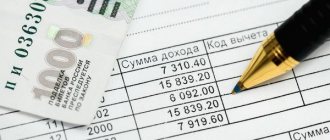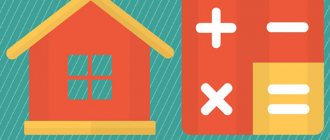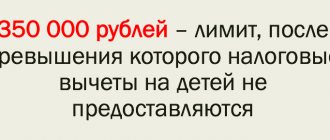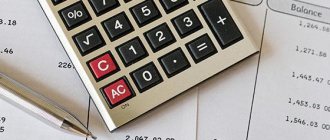Employers must withhold personal income tax (PIT) from their employees' paychecks. Therefore, if an employee has a salary of 30,000 rubles, he will receive only 26,100 rubles in cash minus personal income tax of 13%, if without any difficulties.
In order for some groups of employees to receive more, tax deductions were invented. The deduction works like this: they take the employee’s income, reduce it by the amount of the deduction, and calculate the tax from this amount. That is, they reduce the tax base, and not the tax itself.
Example
Florist Katya has a salary of 30,000 ₽ and a deduction of 1,400 ₽ for her daughter, which means they will deduct from her salary:
- in January: (30,000 - 1,400) × 0.13 = 3,718 ₽
- in February: (60,000 - 2,800) × 0.13 - 3,718 = 3,718 ₽ and so on.
Remember, personal income tax is always considered an accrual total from the beginning of the year as in the example.
Deductions for personal income tax are different: standard, property, social and professional. Most often, employees come with standard tax deductions: for themselves or for a child.
Standard tax deductions reduce income, which is subject to personal income tax at a rate of 13%. Standard deductions are not applied to income at other rates and dividends. Non-residents cannot use deductions either. Let us remind you that a non-resident is an individual who stays on the territory of the Russian Federation for less than 183 days within one year.
Child deduction
Parents are entitled to a deduction for each child under 18 years of age. If the child is a graduate student, resident, intern, student or cadet and is studying full-time, then the age limit is increased to 24 years.
The following may receive a deduction:
- each of the parents - no matter whether they are married, divorced or never married;
- husband or wife of a parent;
- each of the adoptive parents, guardians, trustees, when there are several of them;
- each of the adoptive parents, if there are two of them.
If the only parent or the second parent refused the deduction, you can count on a double deduction. Moreover, only a working parent can refuse the deduction: if the parent does not work, then he does not have the right to the deduction, which means there is nothing to refuse.
Who can apply for social security registration? deductions?
The following citizens can apply for a social tax benefit:
- Officially working citizens paying income tax in the amount of thirteen percent;
- Non-working citizens of retirement age who spend money on medical treatment . However, the recipients of the payment are not themselves, but their children. The only caveat is that you belong to the first category of pensioners.
A prerequisite for receiving social tax deductions is paying income tax.
The payer of this fee may make a partial refund of the funds paid, or be exempt from taxation for a specified period.
Amounts of deductions for children
The deduction amounts are currently as follows:
— for the first and second child — 1,400 ₽
— for the third and each subsequent — 3,000 ₽
Children are counted regardless of age. For example, an employee has three children. Two are already adults: 25 years old and 23 years old, and the third is 16 years old. An employee is entitled to one deduction for a third child - 3,000 rubles.
There are more deductions for disabled children:
— for parents and adoptive parents — 12,000 ₽
— for guardians, trustees, foster parents — 6,000 ₽
It does not matter what type of disabled child is in the family. You can also add general deductions for children. For example, for an only disabled child, the deduction will be 13,400 rubles. After all, parents are entitled to a deduction for their first child - 1,400 rubles and for a disabled child - 12,000 rubles.
Important: provide a standard tax deduction for a child until the month in which the employee’s income from the beginning of the year exceeds 350,000 rubles.
Interesting fact
If a child grows up quickly and gets married, then you can no longer get a deduction for him - now he provides for himself. But if he decides to try his hand at work, then his parents still have the right to a deduction. In general, marriage is a responsible matter :)
STANDARD TAX DEDUCTIONS
Standard tax deductions are specified in Art. 218 Tax Code of the Russian Federation. The law provides for the following types of standard deductions:
- Tax deduction in the amount of 3000 rubles . for each month of the tax period. The following are entitled to this deduction:
- persons who received or suffered radiation sickness and other diseases associated with radiation exposure as a result of the disaster at the Chernobyl nuclear power plant or with work to eliminate the consequences of the disaster at the Chernobyl nuclear power plant;
- military personnel, citizens discharged from military service, as well as those liable for military service, called up for military training and who took part in 1988–1990. in work on the Shelter object;
- persons who became disabled, received or suffered radiation sickness and other diseases as a result of the accident in 1957 at the Mayak production association and the discharge of radioactive waste into the Techa River;
- persons directly involved in testing of nuclear weapons in the atmosphere and radioactive military substances, exercises with the use of such weapons before 01/31/1963;
- persons directly involved in the work (including military personnel) on the assembly of nuclear charges before December 31, 1961;
- persons directly involved in underground testing of nuclear weapons, carrying out and ensuring work on the collection and disposal of radioactive substances;
- disabled people of the Great Patriotic War;
- disabled military personnel who became disabled in groups I, II and III as a result of wounds, contusions or mutilations received while defending the USSR, the Russian Federation or while performing other military service duties, or received as a result of a disease associated with being at the front, or from among former partisans, as well as other categories of disabled people who are equal in pension benefits to the specified categories of military personnel.
An important point: complete information about who has the right to a monthly deduction in the amount of 3,000 rubles is given in subsection. 1 clause 1 art. 218 Tax Code of the Russian Federation.
2. Tax deduction in the amount of 500 rubles . for each month of the tax period. The following categories of taxpayers are entitled to the deduction:
- Heroes of the Soviet Union and Heroes of the Russian Federation;
- persons awarded the Order of Glory of three degrees;
- participants in the Great Patriotic War, military operations to defend the USSR from among military personnel who served in military units, headquarters and institutions that were part of the army, and former partisans;
- persons who were in Leningrad during its siege during the Great Patriotic War from 09/08/1941 to 01/27/1944, regardless of the length of stay;
- former prisoners, including minors, of concentration camps, ghettos and other places of forced detention created by Nazi Germany and its allies during the Second World War;
- disabled people since childhood, etc. (subsection 2, clause 1, article 218 of the Tax Code of the Russian Federation).
3. The tax deduction for each month of the tax period applies to the parent, spouse of the parent, adoptive parent, who supports the child.
For the first and second born child, a deduction is provided in the amount of 1,400 rubles . monthly, and for the third, fourth and subsequent children the amount increases to 3,000 rubles . per month.
Deductions for children are provided from the month of birth of the child until the end of the year in which the right to deduction ends. This right can end for several reasons:
- child's majority (18 years old);
- if he is a student, graduate student, intern, resident or full-time student and is over 24 years old;
- completion of studies before reaching 24 years of age.
EXAMPLE 1
Olga Akimova turned 22 in May, and in June 2021 she received a university diploma. From January 1, 2018, her parents will not be provided with a standard tax deduction for children: Olga is not yet 24 years old, and she has already completed her studies.
If there is a disabled child , then a deduction until he reaches adulthood is provided in the amount of 12,000 rubles . monthly. If this child is a disabled person of the first or second group and is a full-time student at an educational institution, then this deduction amount is provided to his parents until the age of 24.
NOTE
adoptive parents and their spouses is the same as for natural children, only for children with disabilities, the deduction amount is halved ( 6 thousand rubles instead of 12 thousand rubles).
A single parent (custodian, custodian, adoptive parent or foster parent) is entitled to a double deduction , meaning all deductions are doubled. This benefit ends in the month that occurs after the sole parent registers an official marriage.
A double deduction can also be received by one of the parents or adoptive parents. In this case, the second parent writes an official statement that he does not receive deductions and does not claim, and refuses them.
If during a child’s full-time studies at an educational institution, he takes out an academic leave, then the provision of deductions to his parents is not interrupted. Except when he turns 24 during this leave.
Documents for obtaining a deduction for children
The standard tax deduction for children in 2021, as in previous years, is of a declarative nature. This means that the employer does not have the right to independently decide on the application of such deductions.
The law allows you to receive standard deductions only from one place of receipt of income, that is, from one employer. If a citizen works in several organizations, then he himself chooses where to receive standard deductions.
In order for an employer to begin applying deductions, a package of documents must be provided to the organization’s accounting department:
- application for child tax credit;
- birth certificate for each child;
- for a disabled child - a medical report on this fact;
- a certificate from an educational institution if the child is over 18 years old (but under 24 years old) and is a full-time student.
This is a standard set of documents for obtaining deductions for children, but in each individual case the employer may require additional papers :
- decision of the judicial authorities on the adoption of a child or establishment of paternity;
- a copy of the order of the guardianship authorities when determining guardianship or trusteeship of the child;
- marriage certificate, if a spouse (stepmother) or spouse (stepfather) applies for the deduction;
- application of the second spouse to refuse to receive deductions for this child, if one of the spouses wants to receive a double deduction;
- a salary certificate from the previous place of work, if the citizen did not start working in this organization on January 1 of the current year.
Guardians and trustees must have a copy of the document on guardianship or trusteeship of the child:
- resolution of the guardianship and trusteeship body or an extract from the decision (resolution) of the said body on the establishment of guardianship (trusteeship) over the child;
- agreement on the implementation of guardianship or trusteeship;
- agreement on guardianship of a minor citizen;
- foster family agreement.
EXAMPLE 2
Severtsev I.P. had two children in his second marriage: Irina, 5 years old, and Victor, 3 years old. Their joint daughter, Lyudmila, 15 years old, lives with his ex-wife, for whose maintenance Severtsev pays alimony.
B started working in July 2021. He submitted to the accounting department a certificate in form 2-NDFL from his previous place of work, birth certificates of all three children.
In July, Severtsev earned 35,000 rubles . Since the amount of earnings for six months at the previous job amounted to only 150 thousand rubles, the Zarya accounting department quite rightfully calculated the salary for July as follows:
- accrued - 35,000 rubles;
- personal income tax deductions for children: 1400 rubles. (for Lyudmila) + 1400 rub. (for Irina) + 3000 rub. (for Victor) = 5800 rubles;
- personal income tax:
35,000 rub. – 5800 rub. = 29,200 rub. × 0.13 = 3796 rub .
Without standard deductions, the tax would be 4,550 rubles. (RUB 35,000 × 0.13).
Limit on deductions for children in 2021
The standard tax deduction for a child in 2021 has its limitations and takes into account the amount of the taxpayer’s income: a citizen can use the benefit only up to the month in which his income does not exceed a total of 350,000 rubles . That is, employees with high wages have a limit on personal income tax deductions for children.
Income accounting for the provision of a standard deduction is carried out from January 1 on an accrual basis, as is the withholding of tax on this income. That is why, when moving from one company to another during a calendar year, at your old place of work you need to take a salary certificate in Form 2-NDFL and submit it to the new employer.
Documents for child support
First, the employee needs to write a free-form deduction application and attach supporting documents to it: a birth certificate or a certificate from an educational institution.
Deduction application template
If an employee has not been working since the beginning of the year or works part-time in another organization, ask him for a certificate in form 2-NDFL from other places of work. She will confirm that income since the beginning of the year has not exceeded 350,000 rubles.
Important: do not provide an employee with standard tax deductions that he did not receive from his previous employer or did not receive in full.
In some cases, other documents will be needed. For example, from a spouse who is not the child's parent or guardian, ask for a statement from the child's mother or father stating that the spouse is providing for the child.
Some documents need to be updated every year. The general rule: if a document confirms the right to deduction only in one period, then it needs to be updated in the next. For example, request a certificate from the university every year, because the situation may change next year.
Property tax deduction for personal income tax in 2021
The execution of these deductions is regulated by Art. 220 of the Tax Code of the Russian Federation. The deductions themselves are divided into two categories:
- deductions for expenses for the purchase of property;
- deductions upon sale of property.
If a taxpayer sells property, for example, an apartment, which was purchased less than 3 years ago, he must pay income tax on the income received to the state treasury. But if he has documents that confirm the amount of expenses for the purchase of the object being sold, personal income tax is paid precisely from the amount of income received.
Let's give an example.
Sakharov V.V. purchased an apartment in 2021 for 1,500,000.00 rubles. In 2021, he sells it for 1,800,000.00 rubles. He has documents confirming that he purchased the property for 1,500,000.00 rubles. Accordingly, he must pay tax on the amount of 300,000.00 rubles (1800000-1500000).
If there are no documents confirming the fact of purchase of the object being sold, the state provides a deduction in the amount of 1,000,000.00 rubles.
When purchasing real estate (apartment, room, house, land plot, shares/shares in these objects), the state provides a tax deduction in the amount of 2,000,000.00 rubles. Of this amount, the taxpayer has the right to return 13%. That is, 260,000.00 rubles. This amount is received immediately if personal income tax was paid in the same amount on the taxpayer’s income during the tax period. In practice, such cases are rare. As a rule, tax deductions for purchasing property are received over several years.
Let's give an example.
From the salary of S.V. Ivanov, income tax in the amount of 3,500.00 rubles is withheld monthly and transferred to the state treasury. For the tax period, the amount of personal income tax transferred amounted to 42,000.00 rubles. This is the amount he will receive as a tax deduction for the tax period. The balance of the property deduction is carried over to the following periods.
If the property was purchased with a mortgage, the state provides a property tax deduction for the cost of paying mortgage interest in the amount of 3,000,000.00 rubles. Of this amount, the taxpayer can return no more than 390,000.00 rubles.
Child benefit period
Provide a deduction from the month in which the employee confirms that he has a child. If the employee submitted an application in the current year, then provide deductions from the beginning of the year. Even if he declared his right to a deduction in the middle or end of the year.
Example
Alice has been working in the organization since the beginning of the year, but she only remembered that she had the right to a deduction in May, and then she submitted an application. Alisa is a mother and has two minor sons. This means that from January to May, deductions amounted to 14,000 rubles (1,400 × 2 × 5).
Alice has a salary of 40,000 ₽, in total, from January to April, Alice was credited 160,000 ₽ (40,000 × 4) and withheld personal income tax - 20,800 ₽.
In May, the accountant will calculate all unaccounted deductions and only personal income tax will be withheld from the salary in the amount of 3,380 ₽ ((200,000 - 14,000) × 0.13 - 20,800), instead of 5,200 ₽ (200,000 × 0.13 - 20,800). This means that Alice will receive 36,620 ₽ (40,000 - 3,380), instead of 34,800 ₽ (40,000 - 5,200).
But if an employee had the right to a deduction last year and forgot to declare it, then he can only receive this deduction on his own through the tax office.
Filling out 3-NDFL for social deductions
To display social deductions in 3-NDFL, Sheets E1 and E2 are used, which reflect information about exactly what expenses the taxpayer incurred for the calendar year. In this case, the amounts are reflected in the following columns of Sheet E1:
- line 080 for charity deduction (no more than 25% of income);
- line 090 for deductions for children’s education (no more than 50 thousand rubles for each);
- line 100 for deductions for expensive treatment (based on the actual amount of expenses incurred);
- line 110 – total for lines 080-100;
- line 120 for deductions for your own or brother/sister’s education;
- line 130 for deduction for treatment;
- line 140 for deductions for voluntary insurance;
- line 150 for deductions for pension insurance;
- line 160 for deduction for qualification assessment;
- line 170 – total for lines 130-160 (no more than 120 thousand rubles);
- line 171 – deductions provided by the employer;
- line 180 – total for social deductions (total of lines 110 and 170 minus 171).
Sheet E2 reflects specific information about which non-state pension fund the account is opened with, indicating the TIN and KPP of the organization, as well as the date and number of the agreement.
To reflect social deductions in the specialized program for 3-NDFL, a special tab is used, which has an identical name. It must include the amount of deductions claimed by the taxpayer, displaying specific information on pension insurance and children’s education agreements. There is no specific division for each type of deduction, and they can only be viewed based on the submitted documents.
Deduction for yourself
Some adults are entitled to a deduction of 500 ₽ or 3,000 ₽. The amount depends on which benefit category the employee belongs to. Among them are disabled people who suffered from the Chernobyl disaster, participants in military operations, heroes of Russia and many others. All categories can be viewed in paragraphs. 1 and 2 paragraphs 1 art. 218 Tax Code of the Russian Federation.
To receive a deduction, the employee brings an application and documents confirming his right to the deduction.
Such deductions cannot be added and used at the same time. If an employee is entitled to several standard deductions, provide one of them - the maximum. But there is no income limit - provide deductions for yourself regardless of the amount of income received.
Example of using social deductions
This example examines the use of social deductions along with standard deductions.
Employee Zhukov S.P. paid 7,000 rubles for the treatment of his wife in July, 10,000 rubles for the treatment of his mother in November, and 20,000 rubles for his son’s education in August. The deduction is received through the tax authorities.
The calculation of personal income tax in 2021, taking into account new deductions, will look like this:
Table for calculating personal income tax, taking into account social deductions
| Month | Income, rub. | Deduction for yourself | Deduction for son | Deduction for daughter | Deduction for treatment | Deduction for son's education | Tax base, rub. | Personal income tax, rub. | ||
| TOTAL social deductions | 540 000 | 500 rub. | 1,400 rub. | 12,000 rub. | 1,400 rub. | for treatment of his wife | for treatment of mother | |||
| TOTAL social deductions | (1 child) | (disabled student) | (2 child) | (disabled student) | ||||||
| TOTAL social deductions | 540 000 | 6 000 | 9 800 | 84 000 | 9 800 | 430 400 | 55 952 | |||
| July | 7 000 | |||||||||
| October | 20 000 | |||||||||
| November | 10 000 | |||||||||
| TOTAL for the year | 540 000 | 6 000 | 9 800 | 84 000 | 9 800 | 7 000 | 10 000 | 20 000 | 393 400 | 51 142 |
As a result, we get the following results:
- tax without social deductions was 55,952 rubles;
- tax including social deductions is 51,142 rubles;
- when applying to the tax authorities to receive a deduction, the employee will be able to return the difference: 55,952 – 51,142 = 4,810 rubles;
- you can control this value in the following way: (7,000 + 10,000 + 20,000) * 13% = 4,810 rubles.
The mechanism for receiving the deduction is that in 2021 the employee will first be provided with a standard deduction through the employer when calculating wages. Then you need to submit a declaration for 2021, but already in 2021. It reflects that standard deductions were received from the employer, and now the citizen is claiming social deductions and plans to receive exactly the calculated difference.
Deduction for individual entrepreneurs on the simplified tax system and patent
If you are an individual entrepreneur using the simplified tax system or a patent and you have a child, then you will not be able to get a deduction. Your income is not subject to personal income tax at a rate of 13%, so a deduction cannot be applied to it.
But if there is an individual entrepreneur, for example, who simultaneously works for hire, he will receive a deduction from the employer, but this no longer has anything to do with the individual entrepreneur.
Submit reports in three clicks
Elba will calculate taxes and prepare business reports based on the simplified tax system and patent. It will also help you create invoices, acts and invoices.
Try 30 days free Gift for new entrepreneurs A year on “Premium” for individual entrepreneurs under 3 months








